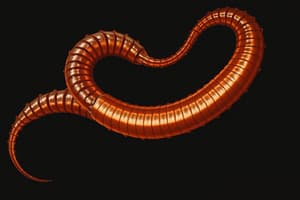Podcast
Questions and Answers
What is Dirofilaria immitis commonly known as?
What is Dirofilaria immitis commonly known as?
- Human Heartworm
- Equine Heartworm
- Feline Heartworm
- Canine Heartworm (correct)
What is the intermediate host of Dirofilaria immitis?
What is the intermediate host of Dirofilaria immitis?
Mosquito
Dirofilaria immitis is only found in dogs.
Dirofilaria immitis is only found in dogs.
False (B)
What phase follows the L1 larvae stage in the mosquito?
What phase follows the L1 larvae stage in the mosquito?
In which body areas do adult Dirofilaria immitis typically reside?
In which body areas do adult Dirofilaria immitis typically reside?
What is a common sign of heartworm infestation?
What is a common sign of heartworm infestation?
How long can circulating microfilaria live in the blood stream?
How long can circulating microfilaria live in the blood stream?
What diagnostic test technique allows for direct viewing of motility?
What diagnostic test technique allows for direct viewing of motility?
Match the following diagnostic techniques for heartworm testing:
Match the following diagnostic techniques for heartworm testing:
Flashcards are hidden until you start studying
Study Notes
Dirofilaria immitis
- Major blood parasite affecting dogs and various wildlife.
- Commonly referred to as "canine heartworm."
- Hosts include dogs, wild canids, felids, marine mammals, and others; humans are accidental hosts.
- Mosquito serves as the intermediate host.
- Widespread globally, more prevalent in southern regions of the U.S.
- Adult males measure 12-16 cm, females 25-30 cm; lifespan up to 8 years in the bloodstream.
- Microfilaria are straight with a tapered end, living up to 2 years in circulation.
Life Cycle of Dirofilaria
- Microfilaria (L1) enter mosquitoes during a blood meal from an infected host.
- L1 develops into infective L3 within approximately 13 days in the mosquito.
- L3 larvae are transmitted to the host through mosquito bites.
- Larvae reach L4 within 3-10 days and reside in connective tissues for several months.
- Transition to L5 immature adults occurs before migrating to pulmonary arteries.
- Mature adults can produce microfilaria 6-9 months post-infection.
Infestation Details
- Microfilaria can circulate in the blood for 2 years; the prepatent period (PPP) is 6-9 months in dogs.
- Infestation primarily occurs via mosquito bites; can also be transplacental if a mother has adults and microfilaria.
- Puppies typically acquire microfilaria but rarely develop into adults; can spread the infection.
- Full-blown infestation: 75% of cases with both adults and microfilaria present.
- Occult infestations: 25% of cases with adults only, often due to non-sexually mature adults or immune destruction of microfilaria.
Site of Infestation
- Adult heartworms commonly reside in the right ventricle and pulmonary artery.
- Microfilaria are found in peripheral blood; larvae circulate in various tissue stages (L1, L3, L4, L5).
Pathogenesis
- L5 microfilaria provoke allergic reactions, leading to eosinophilia, venous congestion, pulmonary embolisms, and respiratory distress.
- Common clinical signs include exercise intolerance, lethargy, dyspnea, and increased capillary refill time (CRT).
- Adult worms obstruct vessels, leading to pulmonary hypertension and potential sudden death.
Diagnostic Testing
- Includes testing for microfilaria and adults through various methods.
Microfilarial Tests
- Techniques include direct drop technique and blood smear/direct smear.
Direct Drop Technique
- Blood sample applied directly to a slide, covered and observed for motility at low magnification.
- Dirofilaria microfilaria are slow-moving with straight tails.
Blood Smear or Direct Smear
- Standard technique used for complete blood count (CBC), involving a drop of blood spread across a slide.
- After staining, the feathered edge is examined for microfilaria and their morphology.
Microhematocrit Technique - Buffy Coat
- Hematocrit tubes filled and centrifuged; then the buffy coat is applied to a slide for examination.
- Differentiation between Dirofilaria and Dipetalonema can be challenging using this method.
Another Microhematocrit Technique
- Spun hematocrit tubes may be placed directly on a microscope slide; microfilaria swim in plasma above the buffy coat.
Saponin Technique
- Whole blood is mixed with saponin to lyse cells; sediment analyzed under a microscope for motility.
Filter Technique
- The Difil test, commonly used, involves filtering blood samples through a membrane to detect microfilaria.
- This involves mixing blood with a lysing solution before filtering and observation.
Studying That Suits You
Use AI to generate personalized quizzes and flashcards to suit your learning preferences.




